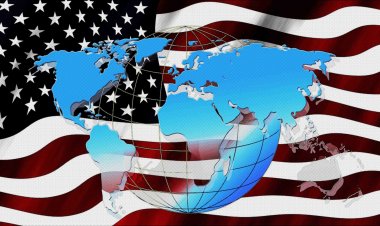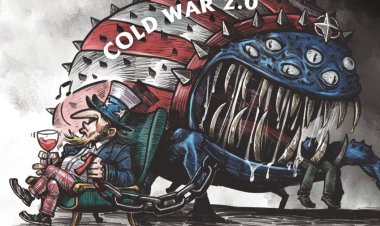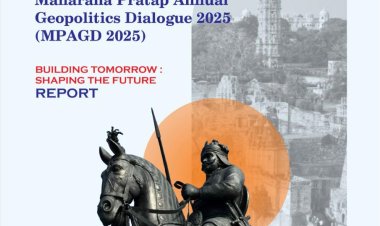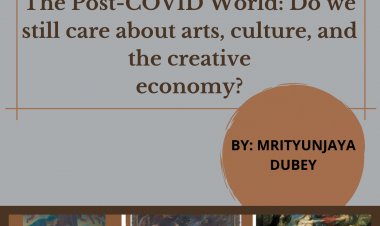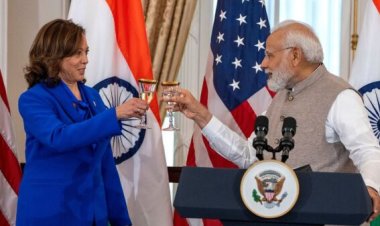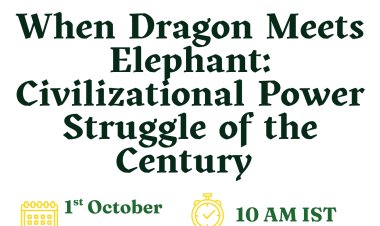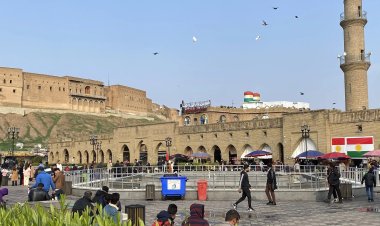Beyond Traditional Diplomacy: The Ascendance of Social Media in India's Foreign Policy
This article aims to understand how social media has played an active role in India’s foreign policy in the recent years as it navigates through a complicated web of international issues.
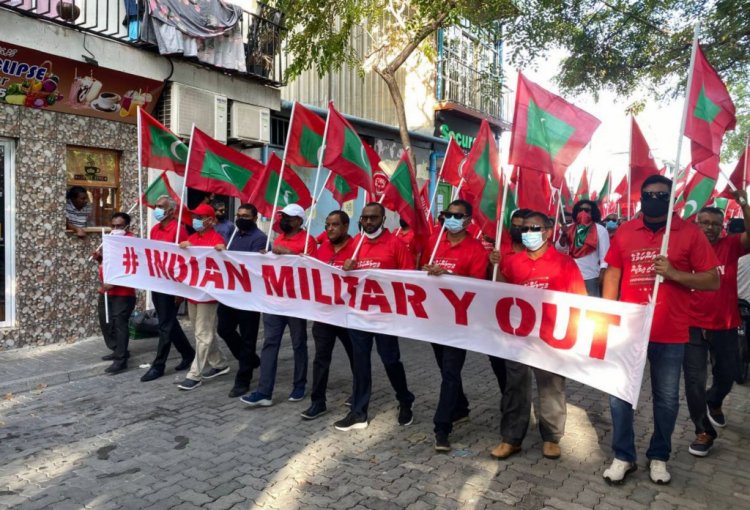
Analysis
By Mehak Johari
What once used to be restricted to the confines of government offices has now been opened to public for interpretation and discussion. With the advent of social media, foreign policy of a country is no longer solely determined by seasoned diplomats and experienced foreign policy experts. Instead, one can witness extensive debates on any and every political move of a government, especially one with international consequences. People have often been seen taking up to social media platforms like X (previously Twitter), the China-owned short video platform Tiktok, and Meta’s Instagram and Facebook to voice their opinions either in favour of or in disagreement of current international events and the stance taken by their governments. These opinions are shared, retweeted, and commented upon by thousands and millions of social media users every day.
Social media today has the power to both consolidate and divide the public on varying issues at the same time. The importance of public perception in guiding government policy is no secret to anyone who pays even a little attention to how politics works but the level of ease that common people have today in being able to voice their opinions while at the same time ensuring that their voice reaches the highest levels of government is something that our previous generation could not have even fathomed. Common people today can not only address higher government officials directly but also have the tools to generate a movement by gathering the support of millions of like-minded social media users to ensure that their voice cannot be easily dismissed. This article aims to understand how social media has played an active role in India’s foreign policy in the recent years as it navigates through a complicated web of international issues.
The event that brought forth the importance of social media and the digital world in influencing a country’s foreign policy is the recent diplomatic row between Maldives and India. Indian PM Narendra Modi, in a tweet on X, posted about his recent visit to the Lakshadweep islands and promoted it as a beautiful travel destination. However, what followed was quite unexpected. In a rather impulsive move to highlight the beauty of the islands in Maldives, the deputy minister of Youth Empowerment in Maldives compared the two islands and made certain remarks on the Indian PM’s visit that did not sit well with the Indian netizens. What followed was a social media war between Maldivian politicians (who have since been suspended for their ‘derogatory remarks’), Indian government officials and the Indian social media users. Hashtags like “BoycottMaldives” and “VisitLakshadweep” started trending on X and Instagram. The impact of this war has been gigantic and catastrophic, especially for the tourism industry in Maldives, which accounts for 28% of its GDP. Travel agents from all over India have received requests for cancellation of flight and hotel reservations in Maldives and have received communication from higher government officials to direct people to other island destinations like Lakshadweep, Andaman and Nicobar Islands, Phuket, Bali, Sri Lanka, and Mauritius. On the other hand, Maldives’ President Muizzu has used this opportunity to cozy up to China and has called the latter “its closest ally and development partner”. The strategic location of Maldives in the Indian Ocean region makes it an important partner for India and the closer it gets to China, the more troublesome the situation can become for India. India and Maldives have managed to maintain cordial diplomatic relations ever since Maldives gained independence from the British in 1965. President Muizzu came to power in November 2023 and his campaign has often expressed an anti-India rhetoric. The recent social media feud merely brought to day light the anti-India sentiment that has been brewing in the dark in some sections of Maldivian politics. Being considered a pro-China leader, Muizzu has shown clear signs of an inclination towards China due to the latter’s promises to invest in the infrastructural and urban development of the island nation. Chinese presence in the Indian Ocean region threatens India’s maritime security and important sea lanes of communications as well as has the potential to disturb the regional power dynamics. Even though experts believe that the recent row is not expected to have any major impact on the India-Maldives bilateral relations, it does make one think of the power that common people have in the form of social media to influence events at an international level.
When Mélanie Joly, Minister of Foreign Affairs of Canada, took to X to share her statement regarding the allegations surrounding the killing of Hardeep Singh Nijjar, designated as a “terrorist” by the Indian government in 2020 for his leadership role in the Khalistan movement (aimed to carve out a separate Sikh state from the Indian state of Punjab), it was her duty to put forth Canada’s stance on the killing of a Canadian citizen on their own soil. It is conventional for government officials to put statements out as a way of communicating with other governments as well as the public – both domestic and foreign. What followed her statement was a massive social media frenzy and a back-and-forth discussion between the supporters of the Khalistan movement and the anti-terrorism/ anti-Khalistan Indian citizens who trashed the Canadian government for housing a “terrorist”. When Canadian President Justin Trudeau hinted towards a possible involvement of the Indian government in what it called the “state-sponsored assassination” of Hardeep Singh Nijjar, it created a stir on social media platforms where people put up not just their own opinions but also gave verdicts of the right and the wrong. These were related to Nijjar’s activities in Canada, Operation Blue Star, the assassination of Indian PM Indira Gandhi by her Sikh bodyguards, the violence incited against Sikhs in India in 1984, and many more. These accounts had a reach of millions of users, most of whom were impressionable young adults, and this is where it became problematic. The blatant glorification of violence on these accounts in the name of Khalistan as well as the spread of fake news and false rumours further fuelled the fire of hatred and mistrust in the society, not only against the Sikh community but also towards Indian government officials as well as the Canadian-Hindus living there. In the first half of 2023, there were attacks and acts of vandalism at the Indian High Commission in Canada and the Indian Consulate in San Francisco (US) with pro-Khalistani elements behind them. The National Investigation Agency (NIA) had to step in to investigate these attacks. While the US condemned these attacks and refused to tolerate such actions against diplomatic facilities and personnel in the US, the Canadian authorities failed to apprehend the main perpetrators on its own soil. In August 2023, a Laxmi Narayan temple was vandalised with pro-Khalistani and anti-Indian posters pasted on its walls. Following these incidents, Chandra Arya, a Member of Parliament in Canada, took to X to call such actions unacceptable and demanded the Canadian authorities to step in and take appropriate disciplinary action against those who misuse their freedom of speech and expression. Similarly, there have been firsthand accounts, videos and pictures shared by the Sikhs and Hindus living in Canada of their suffering amidst these tensions. At the same time, there have been cases of heavy manipulation of photos and videos to misrepresent the events in order to further instigate hatred against the Sikhs and Hindus living in Canada. This has ignited more violence against the Sikh community, further solidifying their resolve for a separate state for Sikhs in India. Even though the Indian government had already dismissed all allegations of any involvement in Nijjar’s death, the virtual turmoil had a major role in the diplomatic row between India and Canada that ultimately led to a halt in the talks for a landmark free trade agreement between the two countries. Additionally, India also stopped issuing visas to Canada because it no longer felt that the latter was safe for Indians due to its inability to act against subversive elements breeding on its soil. International events like these is not a new phenomenon, and thus, leaders and diplomats are quite well-versed in how to handle them but today, social media has become a new and dangerous tool in the hands of extremist elements who would not shy away from any unethical means to achieve their desired outcomes. Hence, regulating social media usage of civilians as well as using it as a diplomatic tool are the only two options that remain in the hands of leaders in this age of digital diplomacy.
Another important way through which social media has been used to influence international events has been by controlling narratives. Today, we live in highly globalised and interconnected world wherein the world is at our fingertips, quite literally. This means that whoever knows how to utilise the power of social media is more likely to be able to swerve future events in their favour. We see this in the Russia-Ukraine war. When the war broke out in the early months of 2022, Russia attempted to shift public support in its favour by using troll farms and automated bots on social media that created an illusion of widespread public support for its actions. Russia used the power of social media to make the world believe in the necessity of its attack on Ukraine. Whether it was able to achieve its desired outcome or not is a debate for another day, but Russia attempted to promote alternative narratives of the conflict on social media to counter the mainstream accounts sponsored by the West. This included presenting the conflict as a way of defending itself from expansionist ambitions of the west as well as protecting the Russian-speaking population residing in Ukraine from the growing discrimination and atrocities of the West’s puppet government installed in Ukraine. On the other hand, Ukraine used social media to counter Russian propaganda and disinformation campaign by establishing fact-checking initiatives to debunk false narratives. Ukrainian government officials, including their president, used various social media platforms to communicate with its public and the international community directly to gain sympathy and support for Ukraine. Various hashtag campaigns like “IStandforPutin” and “HelpUkraine” were used on Twitter and Instagram to mobilize support for both Russia and Ukraine, respectively. While Ukraine and Russia were involved in a virtual battle of narratives in addition to a real on-ground war, various Indian citizens took to these social media platforms to debate the Russia-Ukraine war as well. While the Indian leadership aimed to strike a balance on this international issue by calling for “immediate cessation of violence and hostilities” on one side and abstaining from voting for a UNGA resolution condemning Russia’s invasion of Ukraine on the other, the Indian netizens seemed to have titled their opinion in favour of Russia. A New York Times report observed that India-based Twitter (now X) users were increasingly supporting Russia’s move and focused on ethnonationalism and western hypocrisy by highlighting other conflicts instigated by the Western countries. Even though there were suspicions that majority of these accounts were inauthentic, there have been no concrete proof that these influence campaigns were coordinated and organised to create a pro-Russia narrative in India. Even if these accounts were inauthentic, it did manage to start a conversation where real people started to see merit in Russia’s actions against Ukraine, further encouraging the public narrative in Putin’s favour. This showcases the power of social media and its ability to direct thousands of Indians to support Putin by creating a narrative that enough people bought even when the majority of the world stood against him.
Another hotbed for conspiracy theories and misinformation campaigned emerged last year in one of the most volatile regions in the world, between two neighbours that have been fighting since the mid-20th century. An armed conflict broke out in October 2023 when a Hamas-led Palestinian militant group launched a surprise attack on Israel from the Gaza Strip. In retaliation, the Israeli military undertook extensive aerial bombardment followed by an on-ground invasion of the Gaza Strip. In India, the right-wing (and pro-BJP) citizens sided with Israel, while the ideologically leftist sections declared their solidarity with the Palestinian cause. Indian journalists and intellectuals supporting Israel based their stance on the atrocities committed by the Palestinian militant group as seen in the multiple videos that surfaced on social media platforms right after the surprise attack on October 7, 2023. The Palestinian militant group was seen raping, shooting, amputating, abusing, and murdering innocent Israeli civilians in those videos that horrified anyone who saw them. On the other hand, the progressive-left-liberal intellectuals in India came out to support the Palestinian cause of independence by starting a discussion on the quality of life of those living in the Gaza Strip because of Israel or sharing videos of the violence inflicted by the Israeli army on Palestinian civilians on various social media platforms. They even released a statement of support from celebrities and intellectuals like Arundhati Roy and Ratna Patak Shah, among others. Even today one can find many social media accounts that have Palestinian flags as their display pictures or easily find videos of young Palestinian children reminding people to not forget about the suffering of those in Palestine. This is where it gets tricky. In showing support for the Palestinian national movement and their decades-long struggle against the state of Israel, the leftist sections ended up justifying all of Hamas’ actions as a means of defending the illegally occupied Gaza strip. They, in a way, valorised the violence undertaken by extremist and illiberal groups like Hamas. Given that India’s foreign policy is based on protecting its national interest, the government has attempted to balance its relations with both the Arab world and Israel over the years and advocated for the two-state solution. But the government’s effort to maintain this balance are easily distorted when the popular domestic narrative does not align with the position taken by the government. When large sections of the society take such drastic actions to show support for either Israel or Palestine on social media platforms like X or Instagram, it becomes difficult for the leadership to maintain a neutral position on the issue and reassure either side (and their important allies) of the same.
Digital diplomacy today has immense power and potential to make or break relations, governments, and even well-established systems. Only those actors that understand this potential and make the best use of it can gain an advantageous step ahead of others in this race to power in the international world order. It is imperative that scholars, leaders, academicians, and diplomats keep a check on how it can be best used to achieve their nation’s national interest.
Disclaimer: This paper is the author's individual scholastic contribution and does not necessarily reflect the organization's viewpoint.
Mehak Johari is currently pursuing her second year of Masters in 'Diplomacy, Law and Business' at the esteemed Jindal School of International Affairs (JSIA) at OP Jindal Global University. She holds a degree in Political Science (Hons) from Mithibai College of Arts, Mumbai University. She is the Centre Coordinator of Centre for Security Studies (CSS), a dynamic student-led research center at JSIA.


